Leafenware is everything but the squeal
June 2, 2005
A banana leaf is a plate in Bangalore. The uppermost image shows a Ghandi bazaar (Bangalore) plate maker producing and selling leafenware on the street. The waste products of his production are eaten by noshing cows. This is ‘everything but the squeal’ vegetarian-style.
But Delhi is far far away from the banana climes of the South and an artificial banana leaf plate seems to be a logical substitute. This fabric photoshop job was doing duty as a placemat at drinking club, the Standard at CP before we procured it from the owners for the culiblog packaging archive.
Faithful culiblog readers are familiar with the entry just a few weeks ago of the pepesan sans pep dish, wrapped in bamboo leaves. I am curious about whether bamboo leaves bought at a Chinese supermarket in Amsterdam, imported from somewhere deep in the guts of PRChina qualify as ecologically sound plate choices, but I would like to hear from someone with a strong opinion - or better yet - some actual knowledge on this subject.
Q1: Is a one-use banana leaf plate a more sustainable choice than a ceramic plate in a place where banana trees are harvested?
Q2: Is a pack of dried bamboo leaves a more ecologically sound dinner party option than ceramic plates when the bamboo leaves are imported from PRChina and the dinner party is in the Netherlands? or Occitania?
Q3: Is a re-usable (maybe 100 times) fabric plate more ecological than a ceramic plate if the fabric plate is produced locally? (The plate can be rinsed in soapy water and rinsed clean.)
Q4: Are recycled paper plates like the ones shown in this culiblog entry or the tetra-pak plates more ecological than the different sorts of leaf plates if all of the materials come from local sources?
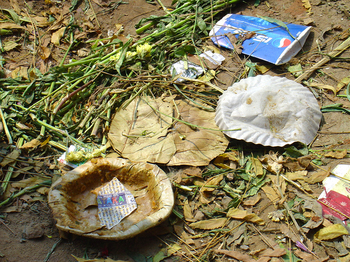
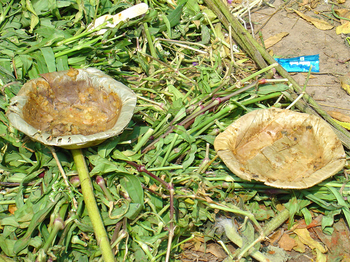
Pictured above are images of leaf plate and other vegetable (and non-veg) trash on the streets of Delhi.
How does one calculate the sustainability of a given object? Ceramic or stainless steel plates are produced under industrial conditions, raw materials possibly imported, packaging distribution all factor in. Imported dried bamboo leaves do quite a lot of travelling. Banana leaves seem ecological (if locally grown) but what are the conditions of the banana plantation and how are the leaves harvested? And what if you already own some plates? And what if you live in the city and don’t have a compost pile or animals with four stomaches roaming the streets?
technorati tags: leafenware, Delhi, sustainability
At an ‘Andhra-style’ restaurant in Bangalore we ate from real banana leaves. It took some getting used to getting a technique together that worked for this sort of wet food.
debra at 9:47 | | post to del.icio.us




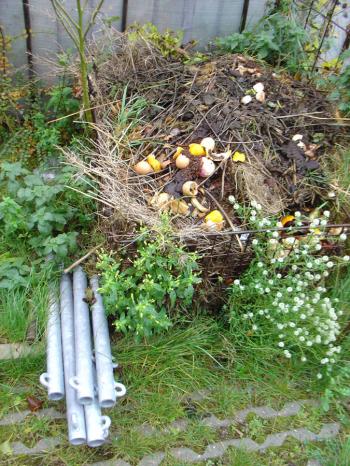
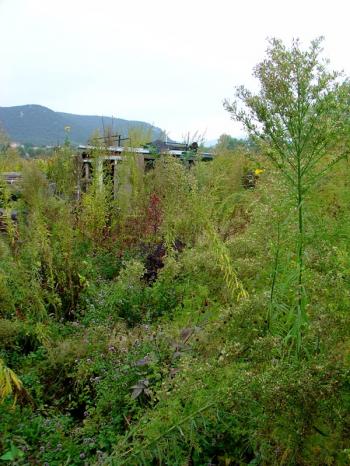
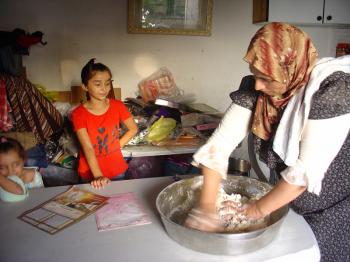







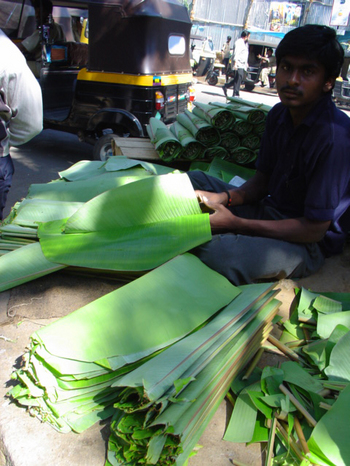
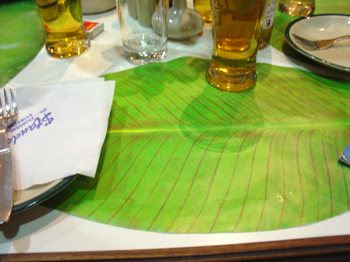
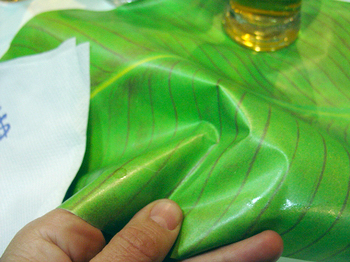
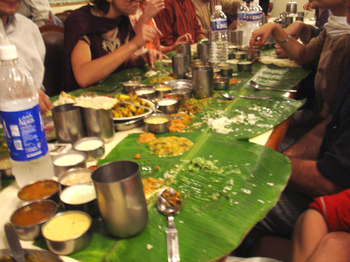
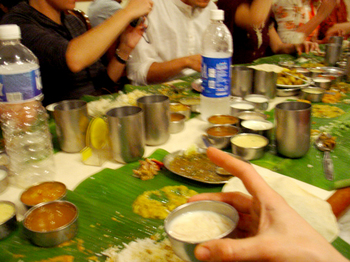
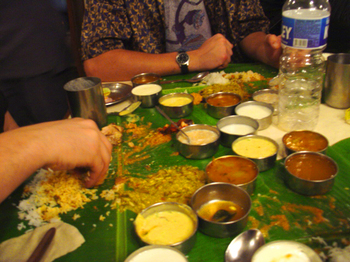
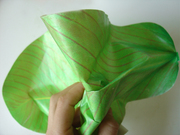
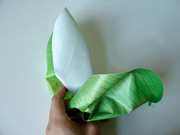



Once the bananas are harvested, they cut down the trees and harvest the leaves, uses them as disposable, one time use only plates in South India. We serve food on bananleaves during special occasions like marriages, prasadam offering to God, festivals etc.
Food tastes quite different when it eaten out of banana leaf than eating out of ceramic and steel plates. That’s what the elders say in India. I think it is true. Did you enjoy the experience?
Comment by Indira — June 2, 2005 @ 16:42
I do very much enjoy the experience of eating off of leaves. I like the softness of the leaf plates in the case of prasad, and the aroma of all of the dried leaf plates when food is put on them. Do you know what sort of leaf the ‘prasad’ and ‘chaat’ leaf plates are?
The banana leaves, I love the sensuality of eating with my fingers and the waxiness of the banana leaves. The plastified photoshopped version that I showed from the Standard at CP, was of course ridiculous and I show it just for fun.
What I most loved was being able to throw the leaf away knowing that it was going to fuel someone’s fire in a few hours. But I am still curious about the ecological soundness of it all. I didn’t realise, for example, that banana trees were killed after harvest. Are you sure about this?
Comment by debra — June 2, 2005 @ 18:32
Linked, a rejoicing of the banana tree, and a call to plant more of them, everywhere!
http://www.trsiyengar.com/id27.html
Comment by Jan Robert — June 3, 2005 @ 16:28
Jan Robert, what a nice link! I especially love the part about the increased oxygen prodcuction around the banana tree - and the link to the 11th moon day fasting day for Brahmins. WIth a recommendation like that, I’m almost afraid to ask about the ‘real cost of a banana tree’. The link is proof positive of cultural payback!
http://www.trsiyengar.com/id27.html
Comment by debra — June 3, 2005 @ 17:51
Oh my gawd, Jan Robert, I feel a banana dance coming on!
And you?
Comment by debra — June 3, 2005 @ 18:23
Thank you folks! I am now satisfied, that the writing give me pleasure to expose the Indian Tradition and the rationale behind each and every practice of my Great Nation!
Quite apart from the usage and utilities, what about the bio-degaradtion point which is most worthy one to note. The present day man made plastics are taking anywhere over 300 years for bio-degradation wherein the Banana Leaves just take 30 full days to get mannure to the earth back!
TRS Iyengar
www.trsiyengar.com
Comment by TRS Iyengar — September 18, 2005 @ 17:45
Hi
I live in the uk and was wondering if anyone knows where I can purchase these Banana Leaf plates.
I have searched high and low on the web with no luck..!
I apologise if this is the wrong place to ask, but I’m all out of options…
Thanks in advance.
Rakesh
Comment by Rakesh Patel — January 21, 2006 @ 11:54
Rakesh, thanks for asking! Unfortunately for you however, this is an entry buried deep within the guts of culiblog, so very few people are likely to see it and offer help.
I will do my best to answer your question, but I should inform you that I have not researched where one could get THESE exact sorts of leafen plates. I do have several suggestions though.
1. Look in your area for an Indian foods supplier. There’s certainly no lack of a whole range of Indian shops all over the UK.
2. Find a gurdwara in your area and ask them, or ask the people that organise events at the gurdwara.
3. Go to a Chinese shop in your area and see what they have in the way of leafenware. It’s not only Indian folks that use it, most everyone in all of Asia uses leafenware, and I’m sure that teh rest of the world is well-represented in the leafenware usage map as well.
In Amsterdam, the Chinese supermarkets have bamboo and lotus leaves that I use constantly for picnics and for food wrapping. Maybe for you this won’t be as traditional as you’re used to, but it STILL is leafenware.
4. Make your own. Maybe there are large leaves growing in your area or maybe at the local farmers’ market you can find leaves that will suit your serviceware needs. In the winter large kale leaves or swiss chard might to nicely. Make sure the leaf isn’t poisonous, however beautiful it might be. Rhubarb leaves would be a BAD choice for this reason.
Good Luck! ANd if you find anything sexy or develop something new in the area of leafenware, I would love to hear about it. Send pictures!
Warm regards,
Debra Solomon
Comment by Debra Solomon — January 21, 2006 @ 15:19
There is a potential in developing banana leaf industry in Sri Lanka. This will help lo-income banana farmer communities. Any one who can support with providing technology, please response.
Comment by Dr. Nimal Kumarasinghe — September 20, 2006 @ 11:42
Can someone please give more information on the process of the leaf plate on the pictures afte Q4, or any link or any information about it? I am working with a community development center and in our area banana plantation are abondant. Thanks for the help
Comment by Olivier L. — September 27, 2007 @ 3:08
I am from Kerala, South India.Fresh banana leaves are in abundance around us that we seldom think about its potentiality to replace the paper/ thermo plates.
Banana leaves have to be made into shape and sturdy so that it can be preserved, packed,transported without any tear and wear.
I am on the look out for such technology.
If anyone can share please do.
thank you.
Comment by sabu antony — March 30, 2008 @ 18:30
SAS Paper Banana Leaf ~ ~ ~ First in INDIA
Highly Suitable for Packing & Serving Food
SAS artificial paper banana leaf is hygienic and eco friendly which can be used for in definite period and available round the year.
Best features :
1. Hygienic and Eco friendly
2. Can be used for in definite period and available round the year
3. Withstand the hot boiling water
4. Parcel leaf & round leaf can be used in buffet sever
5. Remains fresh & usable for many years, even if stored
6. Cannot be torn out, as it is laminated on one side.
Comment by SAS — February 2, 2010 @ 19:39
I wish to know more details for the manufactures of plates made from Banana Leaf.
Points that I wish to understand from them us as follows:-
1. What is the cost of the leafs
2. What is the lot size that is sold by them
3. In case we need to purchase at a larger quantity, what are the bulk rates that they would offer
4. What is the duration of the leaf’s to stay fresh (to be used within hoe many days of purchase)
For more queries, the company persons can also contact us.
Milind
Comment by Milind Gorey — February 5, 2010 @ 9:23
I am the Sidewalkchef,and am starting a reality show where i will be featuring ecofriendly utensils and plates.If you could let me know where to get these Banana Leaf plates it will be much appreciated!!
Comment by Shashank M Agtey — March 25, 2010 @ 3:46
Hi Sidewalk Chef, If you live somewhere where there are lots of bananas, it should be no problem, otherwise, consider what sorts of leaves grow where you are. Also, assuming you go shopping, most Chinese supermarkets have various dried bamboo and lotus leaves. Soak these in water and you’ve got yourself a plate, or a skin to in which wrap whatever you’re making. GOod luck!
Comment by debra — March 25, 2010 @ 7:46
SAS Paper Banana leaf is the trade mark and patent right holder . CFTRI Mysore has certified our product is highly suitable for packing and serving food .SAS Leaf are Eco Friendly and Bio Degedrable as certified .
Comment by S.K.Enterprise — February 13, 2012 @ 13:08